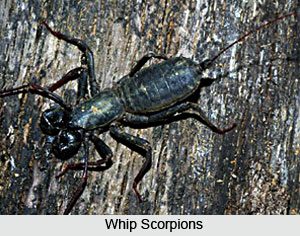 Whip Scorpions (Pedipalpi) are arachnids inhabiting warm countries such as Arabia, India, Africa, tropical and central South America. They have superficial resemblance both to scorpions and spiders. Their pedipalps are stout and end in powerful pincers whereas the first of the four pairs of legs are thin and long and function as feelers. At the posterior end of the segmented abdomen is a whip-like tail.
Whip Scorpions (Pedipalpi) are arachnids inhabiting warm countries such as Arabia, India, Africa, tropical and central South America. They have superficial resemblance both to scorpions and spiders. Their pedipalps are stout and end in powerful pincers whereas the first of the four pairs of legs are thin and long and function as feelers. At the posterior end of the segmented abdomen is a whip-like tail.
Like scorpions they are nocturnal in habits and feed mainly on insects like grasshoppers and cockroaches, and they also eat slugs and worms. They seize the prey in between their two pedipalps and crush them between their special teeth on the inner part of the trochanters (leg`s second segment) of their front legs. During the day they conceal themselves in damp places, under stones, fallen logs, bark of trees and crevices. In view of their sinister appearance they are dreaded as venomous. In fact they are harmless and non-poisonous. They only emit a pungent and nasty acid secretion when handled. This secretion comes out from a pair of glands at the end of the posteriormost abdominal segment. Their food consists of small insects. The evil smelling secretion protects them from their enemies. Thelyphonus is a genus found in India. It has a long slender tail and its body is seven to eight centimetres long.
The whip like tail of the Whip scorpions is secondary in function and because of it they have got their name. After the mating is over, the pregnant female whip scorpion digs particular burrow possessing a very large and spacious area at the end. While the eggs of these whip scorpions hatch, the young ones look white in colour and are very different in appearance from their mother. They then attach themselves with their mother with the help of special suckers and after some time, they however molt and resemble miniature whip scorpions. The Whip scorpions are slow growers and they molt three times which covers a period of three years.



















